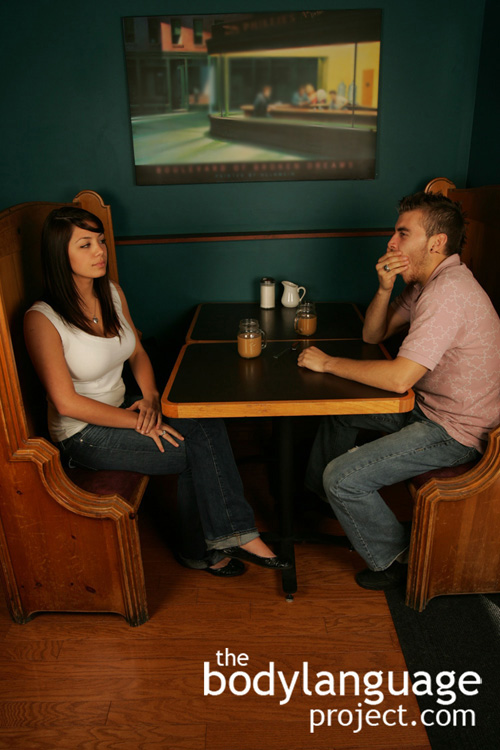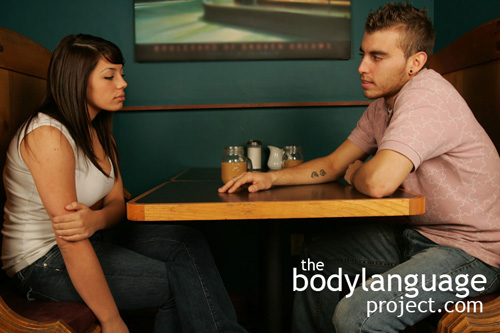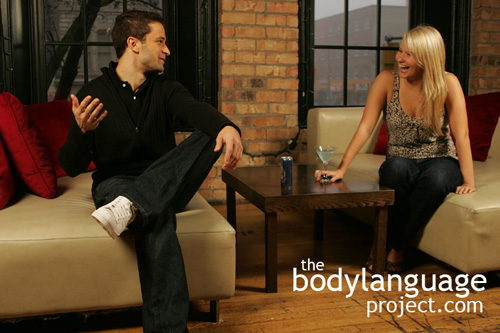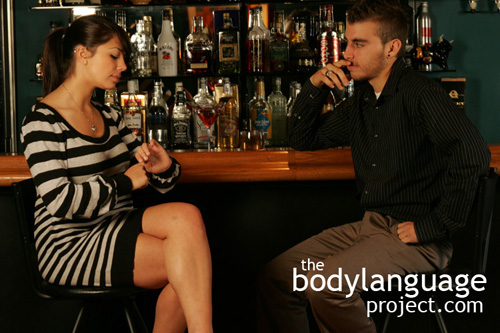Body Language of Sunglasses Body Language
 Cue: Sunglasses Body Language.
Cue: Sunglasses Body Language.
Synonym(s): Removing Sunglasses, Keeping Sunglasses On, Not Removing Sunglasses.
Description: Wearing and removing sunglasses mean various things depending on the context.
In One Sentence: Wearing sunglasses is a sign that one wishes to protect privacy and reduce intimacy or is simply in need of protecting the eyes from damaging ultraviolet rays.
How To Use it: Wearing sunglasses is a great way to reduce the amount of intimacy shared between you and other people. Sunglasses block the eyes which creates a barrier between you and other people. They are effective in concealing more than just the whites of the eyes, but the eyes in total, which eliminates one of the most important connections between people.
Wear sunglasses whenever you want to be shielded from other people and avoid intimate conversations and when you want to conceal emotions. Poker players habitually use sunglasses, even indoors, to hide telling information about their cards. The same is effective in general life.
See Meaning and/or Motivation to deduce more practical applications of sunglasses.
Context: General.
Verbal Translation: a) “I’m keeping my sunglasses on inside this dark room because I want to protect my privacy.” b) “I’m protecting my eyes from the sun and there is no hidden meaning behind my sunglasses.” c) “I’m removing my sunglasses because I want to show that I’m open and honest and want to establish a connection with you.” d) “I’m keeping my sunglasses on because I want to keep my distance from you and protect my privacy – my sunglasses are a barrier between you and me.”
Variant: See Eye Glasses Language.
Cue In Action: a) The celebrity wore his sunglasses from the moment he stepped out of his car until he was out of shot of the cameras b) It was a bright day at the beach and the parents and kids all wore sunglasses to protect their eyes. c) They hadn’t seen each other in almost five years, but as soon as she recognized the familiar face, she removed her sunglasses, said “hi” and gave her a big hug. d) The neighbours struck up a conversation about the loud tenants next door. It wasn’t a particularly sunny day, but both elected to keep their sunglasses on to maintain their privacy.
Meaning and/or Motivation: The main purpose of sunglasses is to protect the eyes from harmful ultraviolet radiation, but when they are worn out of this context, they are laden with hidden meaning.
Sunglasses offer more than protection from the sun, they also protect our eyes from being read. Our eyes hold plenty of potentially hidden information. Those who keep eye glasses on, think celebrities and poker players, while indoors, or in cloudy conditions are telling others that they have a need for secrecy, privacy and to some degree (and in some cases), protection from the bright flashes of the camera.
We habitually see celebrities indoors or in nighttime conditions with sunglasses. This hides the emotion of their face by creating a barrier and also protects their identity. The celebrity is saying, “back off and give me some space and privacy.” When others copy the celebrity-cool-factor by sporting sunglasses indoors it shows that they wish to appear important by feigning celebrity.
Obviously, if we wish to welcome and continue a conversation or increase its effectiveness, we should promptly remove our sunglasses, even in really sunny conditions, so we might benefit from mutual gaze and intimacy. When your counterpart wears glasses, you might both agree to keep them on. However, in so doing, a less intimate encounter will be produced.
Someone that refuses to remove sunglasses is saying that they are a private person and does not want to expose themselves to the judgment and intimacy of others. Wearing sunglasses during a conversation is like hearing the person talk, without really seeing them. It’s like the mythical man behind the curtain where you can never quite get the whole picture.
Conversely, someone that makes a point to remove sunglasses is saying that they want to appear open, honest and create a trusting bond.
Wearing the sunglasses on top of the head can also help to appear cool because it gives the impression of having two sets of eyes. The larger set on top of the head also appear larger with big baby-like pupils. This can work to a person’s advantage.
Alternatively, wearing sunglasses might mean nothing at all. Certain people are particularly sensitive to bright lights and wear sunglasses from the moment they leave the house until they reach their indoor destination.
Cue Cluster: When sunglasses remain on, the face is usually expressionless, the body rigid with body movements controlled and restricted only to that necessary. When sunglasses are removed, expect a person to be full of expression such as smiling, wide eyes (unless the sun is really bright), open gesticulation, and so forth.
Body Language Category: Arrogance or arrogant body language, Barriers, Blocking or Shielding, Closed body language, Disengagement body language, Eye blocking, Eye Language, Indicators of disinterest (IOD), Open body language or openness, Suspicious body language.
Resources:
Aguinis, Herman ; Simonsen, Melissam. ; Pierce, Charlesa. Effects of Nonverbal Behavior on Perceptions of Power Bases. The Journal of Social Psychology. 1998. 138(4): 455-469.
Aguinis, Herman ; Henle, Christinea. Effects of Nonverbal Behavior on Perceptions of a Female Employee’s Power Bases. The Journal of Social Psychology. 2001 141(4): 537-549.
Ariel, Robert and Castel, Alan. Eyes wide open: enhanced pupil dilation when selectively studying important information. Experimental Brain Research, 2014. 232(1):.337-344.
Argyle, M., & Dean, I. Eye contact, distance and affiliation. Sociometry, 1965, 28, 289-304.
Bond, C. F., Kahler, K. N., & Paolicelli, L. M. (1985). The miscommunication of deception: An adaptive perspective. Journal of Experimental Social Psychology, 21, 331–345. doi:10.1016/0022-1031(85)90034-4
Burns, J. A., & Kintz, B. L. (1976). Eye contact while lying during an interview. Bulletin of the Psychonomic Society, 7, 87–89.
Borkenau, P. (1991). Evidence of a correlation between wearing glasses and personality. Personality and Individual Differences, 12, 1125-1128. doi:10.1016/0191-8869(91)90074-L
Baron-Cohen, S., Wheelwright, S., & Jolliffe, T. (1997). Is there a ‘‘language of the eyes’’? Evidence from normal adults, and adults with autism or Asperger syndrome. Visual Cognition, 4, 311–331.
Botz-bornstein, Thorsten.. Veils and sunglasses. Journal of Aesthetics & Culture. 2013. Vol.5(0).
Chen, Yi-Chia ; Yeh, Su-Ling. Look into my eyes and I will see you: Unconscious processing of human gaze. Consciousness and Cognition. 2012 21(4): 1703-1710.
Einav, Shiri ; Hood, Bruce M. García Coll, Cynthia (editor). Tell-Tale Eyes: Children’s Attribution of Gaze Aversion as a Lying Cue. Developmental Psychology. 2008. 44(6): 1655-1667.
Edwards, K. (1987). Effects of sex and glasses on attitudes toward intelligence and attractiveness. Psychological Reports, 60, 590.
Friesen, C.K., & Kingstone, A. (1998). The eyes have it: Reflexive orienting is triggered by nonpredictive gaze. Psychonomic Bulletin and Review, 5, 490–493.
Harris, M. B., Harris, R. J., & Bochner, S. (1982). Fat, four-eyed, and female: Stereotypes of obesity, glasses, and gender. Journal of Applied Social Psychology, 12, 503-516. doi:10.1111/j.1559-1816.1982. tb00882.x
Harris, M.B. (1991). Sex differences in stereotypes of spectacles. Journal of Applied Social Psychology, 21, 1659–1680. doi 10.1111/j.1559-1816.1991.tb00497.x
Horley K, Williams LM, Gonsalvez C, Gordon E (2003) Social phobics do not see eye to eye: a visual scanpath study of emotional expression processing. J Anxiety Disord 17:33–44
Hasart, J. K.,&Hutchinson, K. L. (1993). The effects of eyeglasses on perceptions of interpersonal-attraction. Journal of Social Behavior and Personality, 8, 521–528.
Hellström, A., & Tekle, J. (1994). Person perception through facial photographs: Effects of glasses, hair, and beard on judgments of occupation and personal qualities. European Journal of Social Psychology, 24, 693–705. doi 10.1002/ejsp.2420240606
Haith, M. M., Bergman, T., & Moore, M. J. (1979). Eye contact and face scanning in early infancy. Science, 198, 853–855.
Hockley, William ; Hemsworth, David ; Consoli, Angela. Shades of the mirror effect: Recognition of faces with and without sunglasses. Memory & Cognition. 1999. 27(1): 128-138.
Johansson-Stenmen, O. (2008). Who are the trustworthy, we think? Journal of Economic Behavior & Organization, 68, 456–465. doi:10.1016/j.jebo.2008.08.004
Jenkins, R., Beaver, J.D., & Calder, A.J. (2006). I thought you were looking at me: Direction-specific aftereffects in gaze perception. Psychological Science, 17, 506–513.
Kampe, K.K.W. ; Frith, C.D. ; Dolan, R.J. ; Frith, U. Direct eye contact with attractive faces activates brain areas associated with ‘reward’ and ‘reward expectation’ Neuroimage. 2001. 13(6): 425-425.
Lance, Brent ; Marsella, Stacy. Glances, glares, and glowering: how should a virtual human express emotion through gaze? Autonomous Agents and Multi-Agent Systems, 2010. 20(1): 50-69
Lundberg, J. K., & Sheehan, E. P. (1994). The effects of glasses and weight on perceptions of attractiveness and intelligence. Journal of Social Behavior and Personality, 9, 753–760.
Leder, Helmut ; Forster, Michael ; Gerger, Gernot. The Glasses Stereotype Revisited: Effects of Eyeglasses on Perception, Recognition, and Impression of Faces. Swiss Journal of Psychology. 2011. 70(4): 211-222.
Langton, S. R. H., & Bruce, V. (1999). Reflexive visual orienting in response to the social attention of others. Visual Cognition, 6, 541–567.
Langton, S. R. H., & Bruce, V. (2000). You must see the point: Automatic processing of cues to the direction of social attention. Journal of Experimental Psychology: Human Perception and Performance, 26, 747–757.
McKelvie, S. J. (1995). Emotional expression in upside-down faces: Evidence for configurational and componential processing. The British Journal of Social Psychology, 34, 325–334.
Marzoli, Daniele ; Custodero, Mariagrazia ; Pagliara, Alessandra ; Tommasi, Luca. Sun-induced frowning fosters aggressive feelings. Cognition & Emotion. 2013. 27(8): 1513-1521.
Rieger, Gerulf ; Savin-Williams, Ritch C Kemp, Andrew H. (Editor). The Eyes Have It: Sex and Sexual Orientation Differences in Pupil Dilation Patterns (The Eyes Have It). PLoS ONE, 2012, Vol.7(8), p.e40256.
Rhodes, G., Brake, S., & Atkinson, A. P. (1993). What’s lost in inverted faces? Cognition, 47, 25–57.
Roberson, Debi ; Kikutani, Mariko ; Doge, Paula ; Whitaker, Lydia ; Majid, Asifa. Shades of Emotion: What the Addition of Sunglasses or Masks to Faces Reveals about the Development of Facial Expression Processing. Cognition. 2012. 125(2): 195-206.
Roberson, Debi ; Kikutani, Mariko ; Doge, Paula ; Whitaker, Lydia ; Majid, Asifa. Shades of Emotion: What the Addition of Sunglasses or Masks to Faces Reveals about the Development of Facial Expression Processing. Cognition. 2012. 125(2): 195-206.
Slessor, Gillian ; Phillips, Louise H. ; Bull, Rebecca ; Venturini, Cristina ; Bonny, Emily J. ; Rokaszewicz, Anna. Investigating the “deceiver stereotype”: do older adults associate averted gaze with deception?(Author abstract). The Journals of Gerontology, Series B. 2012. 67(2): 178(6).
Tipples, Jason. Wide eyes and an open mouth enhance facial threat. Cognition & Emotion. 2007. 21(3): 535-557.
Mann, Samantha ; Ewens, Sarah ; Shaw, Dominic ; Vrij, Aldert ; Leal, Sharon ; Hillman, Jackie. Lying Eyes: Why Liars Seek Deliberate Eye Contact. Psychiatry, Psychology and Law. 2013. 20(3): 452-461.
Senju, A., & Johnson, M. H. (2009). The eye contact effect: Mechanisms and development. Trends in Cognitive Science, 13, 127–134.
Schwarzer, G. (2000). Development of face processing: The effect of face inversion. Child Development, 71, 391–401.
Tanaka, J. W., & Farah, M. J. (1993). Parts and wholes in face. Quarterly Journal of Experimental Psychology, 46, 969–993.
Tanaka, J. W., Kay, J. B., Grinnell, E., Stansfield, B., & Szechter, L. (1998). Face recognition in young children: When the whole is greater than the sum of its parts. Visual Cognition, 5, 479–496.
Terry, R. L. (1993). How wearing eyeglasses affects facial recognition. Current Psychology, 12, 151–162. doi 10.1007/ BF02686820
Terry,R. L.,&Hall, C. A. (1989). Affective responses to eyeglasses: Evidence of a sex difference. Journal of American Optometrist Association, 60, 609–611.
Terry, R. L., & Kroger, D.L. (1976). Effects of eye correctives on ratings of attractiveness. Perceptual and Motor Skills, 42, 562. doi 10.2466/PMS.42.2.562
Underwood, M. K.. Glares of Contempt, Eye Rolls of Disgust and Turning Away to Exclude: Non-Verbal Forms of Social Aggression among Girls. Feminism & Psychology. 2004 14(3): 371-375
Valstar, M. F. ; Mehu, M. ; Bihan Jiang, M. ; Pantic, K. ; Scherer, K. Meta-Analysis of the First Facial Expression Recognition Challenge. IEEE Transactions on Systems, Man, and Cybernetics, Part B. 2012. 42(4): 966-979.
Vrij, A., & Semin, G. R. (1996). Lie experts’ beliefs about nonverbal indicators of deception. Journal of Nonverbal Behaviour, 20, 65–81. doi: 10.1007/BF02248715
Wang, Yin ; Newport, Roger ; Hamilton, Antonia F De C. Eye contact enhances mimicry of intransitive hand movements. Biology letters. 2011. 7(1): 7-10.












